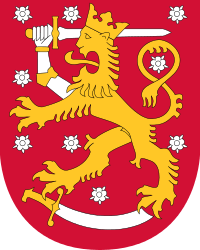Law enforcement in Finland


Law enforcement in Finland is the responsibility of several agencies. The Police of Finland, a national police agency, is responsible for most tasks.[1] The two other main agencies are the Finnish Border Guard and the Finnish Customs. Other agencies with limited police powers are the Finnish Defence Forces, municipal parking inspectors, and some railway staff.
Police of Finland
The Police of Finland is subordinate to the Ministry of the Interior and divided into the National Police Board, two national units and 11 local police departments. Within the departments, there is a division between uniformed patrol police (järjestyspoliisi, "order police") and criminal investigation (rikospoliisi, "criminal police"). The function of each police department is to maintain general law and order, prevent crime, investigate crime and other events that threaten public order and safety, to carry out traffic control and surveillance and promote traffic safety.
The national units are the National Bureau of Investigation, which is a national investigation unit, and the Police University College, which is responsible for police training, research and development.[2] The Police Rapid Response Unit (Finnish: Poliisin valmiusyksikkö), also known as Bear Group (Finnish: Karhu-ryhmä), is under the authority of the Helsinki police department but may operate throughout the country.
Finnish Security Intelligence Service
The Finnish Security Intelligence Service (Suojelupoliisi, Supo) specializes in "the prevention of security threats of the State,"[3] such as counterintelligence and terrorism. Supo was a police agency but was moved directly under the Ministry of the Interior in 2016.[4]
Customs and Border Guards
The Finnish Border Guard have police powers in border zones; likewise, Finnish Customs have police powers when dealing with arriving persons and goods. Within their fields of work, the Customs and Border Guard officers have most police powers. In the Customs, the power to arrest is delegated to the level of senior customs inspectors. In the Border Guard, the power to arrest is delegated to the level of border control detachments commander.[5] The Border Guard is also responsible for search and rescue and maritime search and rescue. The Customs may utilize all investigative police powers, with the exception of the use of deep-cover personnel and sting operations.[6] The Border Guard may use almost all investigative powers. The Customs also occasionally enforces laws such as fuel taxes and vehicle traffic-worthiness, without connection to imported goods.
PTR

PTR (poliisi, tulli ja rajavartiolaitos) is a scheme for cooperation between the police, customs and border guard. In a PTR patrol, there is a patrol from two of the agencies, for instance two officers from customs and two from police, who then get acquainted with each other's tasks and expertise. Another form of PTR cooperation is in criminal intelligence.
Finnish Defence Forces

The Finnish Defence Forces have provost duties and jurisdiction over guarding military installations. The Defence Forces also have the right to investigate all military crimes and most crimes committed by service-men against non-civilians. In addition, the Defence Forces have the right to conduct counter-espionage and counter-sabotage activities related to the national defence. However, Suojelupoliisi conducts actual criminal investigations of state-security-related crimes also within the Defence Forces. Military unit commanders have the jurisdiction over the investigations of minor infractions.[7][8]
The power to arrest is delegated to company commander level. More serious crimes are investigated, by the investigative section of the Finnish Defence Command or by the military attorneys of lower command levels. Security-related military police activities and all technical surveillance activities are carried out by the investigative section of the Defence Command. The Defence Forces do not have the right to conduct wiretaps or other forcible measures against Finnish civilian telecommunications.[7][8]
The police may request assistance in performing their duties from the Defence Forces or other agencies, when special equipment or competency is required. The operation remains under the command of the police. Military units (brigades) usually keep a company under readiness for assistance at all times; the turn rotates among companies and requires them to forego regular leave. In practice, the Defence Forces have assisted in disposal of explosives, provided Pasi armored vehicles for operations against heavily armed suspects in e.g. the Kauhajoki shooting, and conscript manpower for search of missing persons in terrain and in handling of the 2015 refugee crisis.[9]
Finnish military police and investigative command is trained in and will assume a more extensive set of tasks in wartime.
Miscellaneous
Municipal parking inspectors, train conductors and ticket inspectors and fishing inspectors have limited police powers. The Ministry of the Interior has the authority to grant police powers to any person for a specific task and to the degree necessary.
Voluntary support
The Finnish police is supported by two voluntary organisations: Vapepa, the voluntary rescue service (Finnish: Vapaaehtoinen pelastuspalvelu), and the SRVA, the assistance organisation for large game situations (Finnish: suurriistavirka-apu). Neither organisation uses police powers during assistance missions.
The most typical support mission for the Vapepa is a search mission. The organisation is composed of volunteers trained in the search of missing persons, who can be alerted by the local police for a search with a reasonably short response time.[10] For example, in a recent case, the person was reported missing at 4 PM, the Vapepa search operation started with 42 volunteers at 7 PM, and continued at 7 AM the following morning, after being stopped at 4 AM, with more than 100 volunteers.[11][12] In addition, the Vapepa may support police in communications or first-response logistics and psychological care.[13]
The SRVA is a voluntary activity organised by the semi-governmental hunting district associations (Finnish: riistanhoitoyhdistys). The SRVA personnel are experienced hunters trained for police assistance, and they provide hounds and armed hunters to track and euthanise large game that has been wounded in a traffic accident or that police has decided to euthanise to prevent danger to human safety.[14]
See also
Notes
- ↑ Finnish Police official in English. Retrieved 5 Sep 2007
- ↑ http://www.poliisi.fi/about_the_police/organisation
- ↑ Supo official in English Retrieved 5 Sep 2007
- ↑ http://yle.fi/uutiset/osasto/news/government_advances_plan_to_move_supo_to_interior_ministry/7713633
- ↑ Pakkokeinolaki (450/1987), 6§. Retrieved 2010-02-15. (Finnish)
- ↑ Tullilaki (466/1999). 43§ Retrieved 2010-02-15. (Finnish)
- 1 2 Laki poliisin tehtävien suorittamisesta puolustusvoimissa (1251/1995). Retrieved 2010-02-15. (Finnish)
- 1 2 Sotilaskurinpitolaki (331/1983), Chapter 4. Retrieved 2010-02-15. (Finnish)
- ↑ http://yle.fi/uutiset/puolustusvoimat_lahettaa_sotilaita_tornioon_auttamaan_pakolaisten_ohjaamisessa/8321342
- ↑ Etsintä. Vapaaehtoinen pelastuspalvelu. Retrieved 2015-10-20. (Finnish)
- ↑ Posiolla massiivinen etsintäoperaatio kadonneen 10-vuotiaan löytämiseksi. Yle 2015-10-18. Retrieved 2015-10-20. (Finnish)
- ↑ Posion etsintä 17. 18.10.2015. Vapepa 2015-10-20. Retrieved 2015-10-20. (Finnish).
- ↑ Osaavien auttajien verkosto. Vapaaehtoinen pelastuspalvelu. Retrieved 2015-10-20. (Finnish)
- ↑ Suurriistavirka-apu (SRVA). Finnish Ministry of Agricuilture and Forestry. Retrieved 2015-10-20. (Finnish).
External links
![]() Media related to Law enforcement in Finland at Wikimedia Commons
Media related to Law enforcement in Finland at Wikimedia Commons
